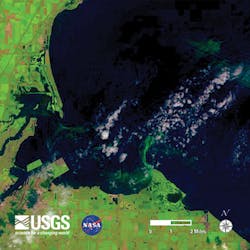| Lake Erie's algal bloom off of Toledo, Ohio, as seen from a satellite image from USGS on Aug. 1, 2014. (Photo courtesy USGS.) |
The agencies plan to convert color satellite data that was designed to probe ocean biology into information that indicates freshwater algal blooms.
They expect to issue public health advisories based on the information. They also expect to improve the understanding of the environmental causes and health effects of cyanobacteria and phytoplankton blooms.
After an algal bloom last August in Lake Erie, the presence of the cyanotoxin microcystin in the drinking water of Toledo, Ohio, forced the city to issue a "Do Not Drink" advisory.
In March, the House of Representatives passed a bill directing EPA to draft a strategy to assess and manage risks associated with harmful cyanotoxins in drinking water. A companion bill is pending in the Senate (see "http://www.waterworld.com/content/ww/en/articles/print/volume-31/issue-4/inside-every-issue/washington-update/congress-mulls-legislation-to-address-algal-toxins.html">Congress Mulls Legislation to Address Algal Toxins," WW, April 2015).
NOAA stated that under certain environmental conditions, algae naturally occurring in marine and fresh waters can rapidly multiply and create a toxic bloom, raising human and animal health risks. Cyanobacteria is of particular concern because it produces toxins that can kill wildlife and domestic animals and cause illness in humans.
NOAA also noted that freshwater algal blooms are estimated to cost the nation $64 million per year in additional drinking water treatment, loss of recreational water usage, and declines in waterfront real-estate values.
The initiative will build on previous NASA ocean satellite sensor technologies created to study the global ocean's microscopic algal communities, which play a major role in ocean ecology, the movement of carbon dioxide between the atmosphere and ocean, and climate change. These sensors detect the color of the sunlit upper layer of the ocean and are used to create indicators that can help identify harmful algal blooms.
NOAA and NASA have pioneered the use of this satellite data for monitoring and forecasting harmful algal blooms. Satellite data allows for more frequent observations over broader areas than water sampling. The data also supports NOAA's existing harmful algae forecasting systems in the Gulf of Mexico and Great Lakes.
The sponsors said that the first step will be to create a standard method for identifying cyanobacteria blooms in freshwater lakes and reservoirs using ocean color satellite data. Several satellite data sets will be evaluated and tested against environmental data from these waterbodies. The project will convert the satellite data to a format that the public can access through mobile devices and web portals.
The research component of the project will seek to improve understanding of the environmental causes and health impacts of cyanobacteria and phytoplankton blooms. Those blooms result from aquatic plants receiving excess nutrients from watershed runoff, as well as other environmental conditions such as temperature and light. Some land uses and agricultural practices have changed the volumes of nutrients and sediment delivered in watersheds, which can influence cyanobacterial growth.
Researchers will compare the new freshwater algal bloom satellite data with satellite records of land cover changes to explore which land-use activities may have caused environmental changes linked to the frequency and intensity of observed blooms. Those studies will help improve forecasts of bloom events.
About the Author: Patrick Crow covered the U.S. Congress and federal agencies for 21 years as a reporter for industry magazines. He has reported on water issues for the past 15 years. Crow is now an Austin, Texas-based freelance writer.
More WaterWorld Current Issue Articles
More WaterWorld Archives Issue Articles



